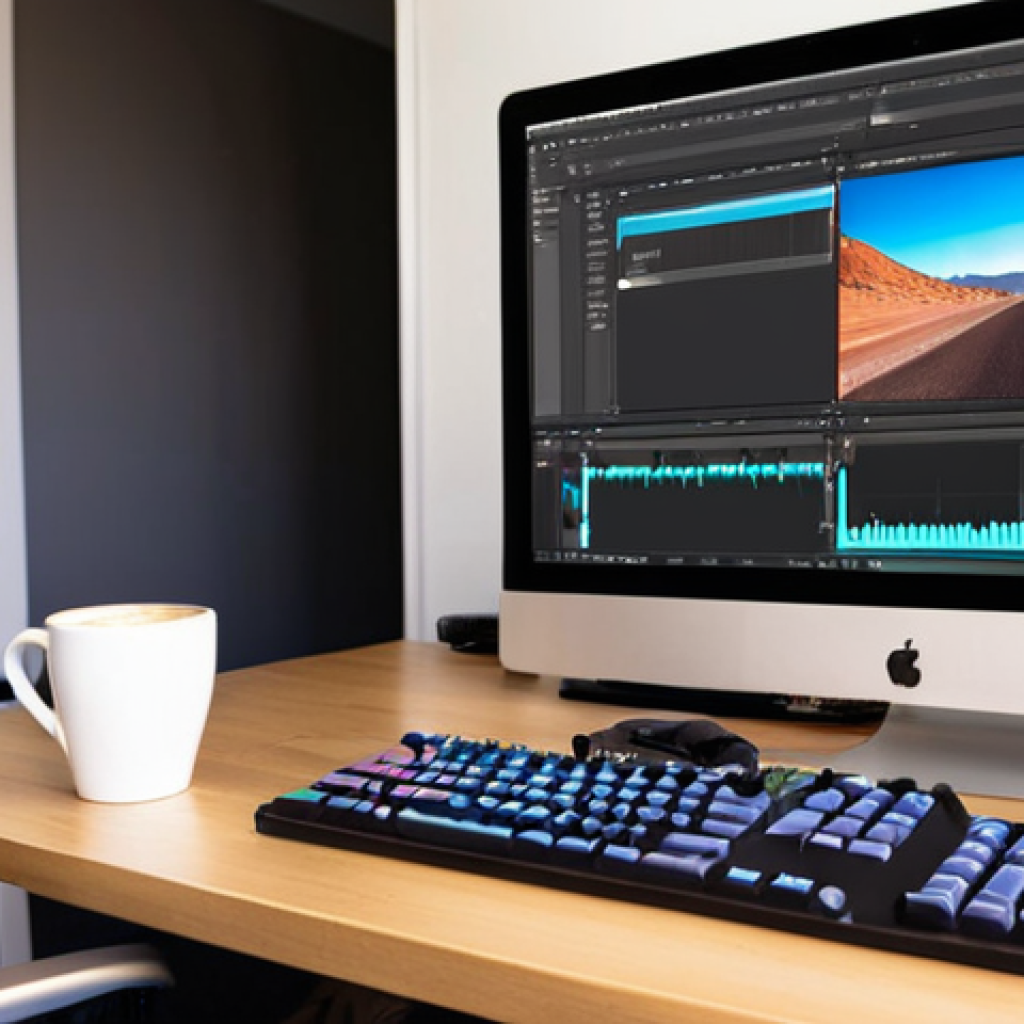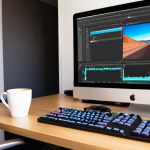So, you’re diving into the world of video production and feeling a little overwhelmed? I get it! I remember when I first started, I was lost in a sea of technical jargon and creative approaches.
Finding the right resources felt like searching for a needle in a haystack. Luckily, there are some amazing books out there that can seriously cut through the noise and set you on the right path, no matter what specific video job you’re aiming for.
Think of these books as your personal mentors, guiding you through everything from basic storytelling to advanced editing techniques. Let’s explore these invaluable resources and get you started on building your skillset, shall we?
Okay, here’s the blog post:
Unlock Your Creative Vision: Mastering Video’s Foundational Principles

Video production isn’t just about pointing a camera and hitting record; it’s about understanding how light, sound, and composition work together to tell a story.
I’ve seen countless aspiring filmmakers get hung up on fancy equipment before they even grasp the basics, and trust me, that’s putting the cart before the horse.
You can create compelling content with minimal gear if you have a solid understanding of these principles.
Light: Painting with Illumination
Light shapes the mood and guides the viewer’s eye. Experiment with different lighting setups—three-point lighting, natural light, hard vs. soft light—to see how they affect the scene.
I remember one time I was filming a short interview in a dimly lit room. The footage was unusable until I brought in a simple reflector to bounce some light onto the subject’s face.
It made a world of difference.
Sound: Capturing Clarity
Good sound is often more important than good visuals. Viewers will forgive slightly grainy video, but they won’t tolerate poor audio. Invest in a decent microphone (even a basic lavalier mic will do) and learn how to properly position it.
Wind noise and background distractions can ruin an otherwise perfect shot. I once spent hours filming an outdoor scene, only to realize later that a nearby construction site had completely ruined the audio.
Lesson learned!
Composition: Framing the Narrative
Composition involves arranging the elements within your frame to create a visually appealing and engaging image. Learn about the rule of thirds, leading lines, and negative space.
Think about what you want the viewer to focus on and how you can use the frame to draw their attention.
Demystifying the Editing Room: Transforming Raw Footage into Storytelling Gold
Editing is where the magic happens. You can take hours of raw footage and sculpt it into a compelling narrative. Don’t be intimidated by the software; start with the basics and gradually explore more advanced techniques.
Understanding editing software, keyboard shortcuts and the power of color correction is vital.
Understanding Editing Software
Whether you choose Adobe Premiere Pro, Final Cut Pro, or DaVinci Resolve, the key is to become comfortable with the interface and core functionalities.
Watch tutorials, experiment with different tools, and don’t be afraid to make mistakes. The undo button is your best friend! I remember when I first started editing, I accidentally deleted an entire scene.
It took me hours to recreate it, but I learned a valuable lesson about saving my work frequently.
Keyboard Shortcuts are Your Friend
Mastering keyboard shortcuts will dramatically speed up your editing workflow. Learn the most common shortcuts for cutting, trimming, and moving clips.
Your wrists will thank you.
The Power of Color Correction
Color correction can transform the mood and atmosphere of your video. Learn how to adjust exposure, contrast, and color balance. Even subtle tweaks can make a big difference.
I always try to match the color grading to the overall tone of the video. A gritty documentary will have a different look than a lighthearted comedy.
Storytelling Through the Lens: Crafting Narratives that Resonate
Even if your video is visually stunning, it will fall flat if it doesn’t tell a good story. Learn the fundamentals of storytelling, including character development, plot structure, and conflict resolution.
Character Development
Viewers need to connect with the characters in your video. Give them believable motivations, flaws, and goals. Think about what makes your characters unique and how they change over the course of the story.
A flat, one-dimensional character can sink an otherwise great video.
Plot Structure: Guiding the Audience
A well-structured plot will keep viewers engaged from beginning to end. Learn about the classic story arc—exposition, rising action, climax, falling action, and resolution.
I try to think of my videos as a rollercoaster ride, with ups and downs that keep the audience on the edge of their seats.
Conflict Resolution: Driving the Narrative
Conflict is the engine that drives the plot forward. It can be internal (a character struggling with their own demons) or external (a character battling an outside force).
Think about how the conflict will be resolved and what the characters will learn along the way.
Conquering the Technical Terrain: Grasping the Essential Gear
While creativity is paramount, a basic understanding of video equipment is also crucial. Understanding what equipment is available and how it will serve your vision is a key element in the video creation process.
Cameras
Cameras are your eyes. Familiarize yourself with camera types like DSLR, mirrorless, cinema cameras, and even your smartphone camera. Learn about sensor size, frame rates, resolution, and codecs.
Microphones
Microphones capture the sound that brings your stories to life. Explore lavalier mics, shotgun mics, and studio mics.
Lighting
Lighting illuminates your scenes and can be used to create mood and drama. Learn about LED panels, softboxes, and reflectors.
Unlocking the Business of Video: Navigating Freelancing and Career Paths
Making videos is fun, but turning it into a career requires business acumen. Understanding contracts, building your network, and marketing your skills are essential.
Contracts: Protecting Your Interests
Always have a contract in place before starting any video project. It should outline the scope of work, payment terms, deadlines, and ownership rights.
Networking: Building Connections
Attend industry events, join online communities, and connect with other video professionals. Networking can lead to new opportunities and collaborations.
Marketing: Showcasing Your Skills
Create a professional website or online portfolio to showcase your best work. Use social media to promote your videos and build your brand.
Monetizing Your Masterpiece: Turning Views into Revenue Streams
Turning your passion into profit is the dream of many video creators. Here’s a quick guide to some of the major ways you can monetize your video expertise.
YouTube
Monetize your YouTube channel through ads, sponsorships, and merchandise sales. You need 1,000 subscribers and 4,000 valid watch hours in the past 12 months to be eligible for the YouTube Partner Program.
Freelancing
Offer your video production services to clients on a freelance basis. You can find work on platforms like Upwork, Fiverr, and LinkedIn.
Selling Courses
Create and sell online video courses on platforms like Udemy and Skillshare. This can be a great way to share your knowledge and earn passive income.
Here’s a table to illustrate the different aspects of video production discussed, categorized by skill level:
| Skill Level | Category | Key Aspects | Essential Tools | Monetization Strategies |
|---|---|---|---|---|
| Beginner | Foundational | Lighting, Sound, Composition, Storytelling Basics | Smartphone, Basic Microphone, Natural Light | Building a Portfolio, Free Projects |
| Intermediate | Technical | Editing Software, Keyboard Shortcuts, Color Correction, Camera Operation | Editing Software (Premiere Pro, Final Cut Pro), DSLR/Mirrorless Camera, Basic Lighting Kit | Freelance Projects, YouTube Channel (Unmonetized) |
| Advanced | Business & Creative | Character Development, Plot Structure, Conflict Resolution, Contracts, Networking | Cinema Camera, Advanced Lighting and Sound Equipment, Legal Templates | YouTube Monetization, Selling Courses, High-End Freelance Work |
Staying Ahead of the Curve: Embracing Trends and Technological Shifts
The video landscape is constantly evolving, so it’s important to stay up-to-date on the latest trends and technologies. Embrace new formats, experiment with emerging platforms, and never stop learning.
Virtual Reality and 360 Video
VR and 360 video are becoming increasingly popular, offering immersive experiences that can transport viewers to another world.
Live Streaming
Live streaming is a great way to connect with your audience in real time. Platforms like YouTube Live, Facebook Live, and Twitch offer a variety of live streaming tools.
Artificial Intelligence
AI is revolutionizing video production, with tools that can automate tasks like editing, color correction, and sound design.
Polishing Your Projects: The Importance of Audio and Color Grading
The finishing touches can make all the difference. Taking care of your audio mixing is key, and so is knowing how to match color grading to the video’s mood.
Perfecting Audio Mixing
Making sure the audio is crisp and clear is essential. It can truly make or break the viewing experience. * Pay close attention to the balance of each level.
* Reduce white noise, and
* Make sure there’s no hissing or popping.
Understanding Color Grading
You can use color to set the mood of your video. Match the colors to the emotional core for the best possible outcome. * Don’t overdo the color.
* Try color matching shots, and
* Learn to work with the scopes.
Bringing It All Together
So there you have it! A comprehensive dive into the world of video creation, from understanding the basic principles to navigating the business side of things. Remember, practice makes perfect, and the video world is always evolving, so keep experimenting and never stop learning. It’s a journey filled with creative expression, technical challenges, and endless opportunities to connect with audiences around the globe. Now go out there and make some magic happen!
Handy Tips to Keep in Your Back Pocket
1. Always bring extra batteries. Seriously, always.
2. Invest in a good tripod. Shaky footage is a no-go.
3. Learn the basics of storyboarding. It’ll save you time and headaches later.
4. Embrace constructive criticism. It’s how you grow.
5. Network, network, network! You never know where your next opportunity will come from.
Key Takeaways
Master the fundamentals of lighting, sound, and composition to elevate your video quality.
Become proficient with editing software and keyboard shortcuts to streamline your workflow.
Craft compelling narratives with well-developed characters, engaging plot structures, and meaningful conflict resolution.
Develop a strong business acumen by understanding contracts, networking with industry professionals, and effectively marketing your skills.
Explore diverse monetization strategies like YouTube monetization, freelancing, and selling online courses to generate revenue from your video expertise.
Frequently Asked Questions (FAQ) 📖
Q: I’m a complete beginner, never touched video editing software before. Will these books be too advanced for me?
A: Absolutely not! Many of these books cater specifically to beginners. Think of them like “Video Production 101.” They break down complex concepts into digestible chunks, often with step-by-step guides and visual examples.
For example, “The Five C’s of Cinematography” starts with the fundamentals of camera angles and lighting, assuming you know next to nothing. I remember when I first opened that book, I felt like a veil had been lifted.
Suddenly, professional-looking videos seemed achievable. It’s all about finding the right book that speaks to your current level.
Q: I’m on a really tight budget.
A: re there any affordable options or ways to access these books without breaking the bank? A2: Definitely! The great thing is, many libraries carry a decent selection of video production books, and you can borrow them for free.
I’ve personally saved a ton of money by utilizing my local library system. Also, consider checking out used bookstores or online marketplaces like Amazon for discounted copies.
Another tip: keep an eye out for ebook versions, which are often cheaper than physical copies. Plus, some authors and organizations offer free online resources or sample chapters that can give you a taste of the book’s content before you commit to buying.
You might be surprised at what’s available without spending a fortune.
Q: I’m interested in a specific type of video production, like creating YouTube content or filmmaking. Will these general books still be helpful?
A: Yes, absolutely! While some books might cover a broad range of video production topics, the core principles are often transferable. For instance, understanding storytelling techniques is crucial for any type of video, whether it’s a short film or a vlog.
“Save the Cat! Writes for TV” (which is listed in the suggested books) is a great resource for the fundamentals of storytelling, regardless of the platform.
Once you have a solid grasp of the fundamentals, you can then dive into more specialized resources for your particular niche. Think of it as building a strong foundation before adding the specific flourishes that match your unique style and content.
📚 References
Wikipedia Encyclopedia
구글 검색 결과
구글 검색 결과
구글 검색 결과
구글 검색 결과

